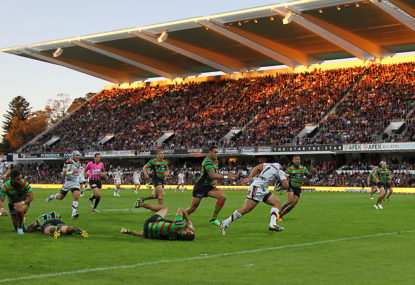The CEO of the NRL, Dave Smith, recently announced that rugby league will be the biggest sport in the country by 2017. Ambitious? Yes. Realistic? No.
In the grand scheme of things, rugby league currently sits third in terms of Australia’s most-followed sports behind cricket and Australian rules football – and they are both pretty far ahead.
By 2017, the NRL wants to have doubled club memberships to 400,000, increasing average crowds by 7,000 to 20,000, increasing participation rates from 555,000 to 700,000 and negotiating a better TV deal.
Barring the last aim, the thought of achieving these in just five short years is laughable.
Even if by some miracle they do achieve these key points, rugby league still won’t be the biggest sport in the country.
WATCH EVERY NRL GAME THIS SEASON WITH FOXTEL PLAY
There are 850,155 registered cricketers in Australia, while a 2011 study showed that 93.6% of Australians watched at least some cricket during the 2010-11 summer.
A more accurate comparison to the NRL would be the AFL. The Barassi line is non-existent when speaking of cricket, but comes into play when comparing these two football codes.
AFL club memberships totaled at 670,811 for 2013, with an average of 32,163 attending each game. This means that the AFL has the fourth-highest average crowd of any sporting league in the world, while the NRL doesn’t even rank inside the top 10.
While it may not become the biggest sport in Australia, there certainly has been a lot of optimism surrounding rugby league following the appointment of the new CEO in late 2012.
However, some things still haven’t changed. Rugby League is still too fixated on its heartland.
For the first time since 1994, seven matches of the opening round of the season were to be played in New South Wales. This leaves only one game being played outside of the state, that being in North Queensland.
Three of those seven matches will be played at ANZ Stadium. Sure, it may be the biggest stadium in Sydney, but the general consensus is that not too many people like it.
An example of this was seen last Thursday night.
Last season, 35,952 packed into Allianz Stadium to watch South Sydney and Sydney do battle. On Thursday, the attendance was 27,282.
Of course, 27,282 is still a fantastic crowd for the NRL, but in the context, it could’ve pulled in many, many more fans.
These two clubs hold arguably the biggest rivalry in the league, however the majority of both club’s fans live and work in the city’s east, not in the west where ANZ Stadium is located.
The trip out west is not one that should be taken lightly. The prospect of arriving home at a late time on a Thursday night and having to front up to work the next day would have turned many people off.
Why do that when they can just watch in on TV?
Had the game been at Moore Park once again, the crowd would definitely have been larger. This is a massive opportunity lost.
The NRL also starts one week before the AFL season. Why not take advantage of the gap and schedule matches around the country in areas that don’t have teams?
While some may not agree, games in Adelaide and Perth to open the season would have been great. The clubs and the league would both benefit from the added exposure and give the code a one-up on their main rival.
But perhaps what is most ridiculous is the fact that Melbourne played their first game away to Manly.
Barring the A-League match on Friday night, it was a sports-free weekend in the ‘sporting capital of Australia’ and the NRL has failed to take advantage of this.
It is simple things like these that are severely hindering the NRL’s chances of making rugby league the biggest sport in Australia.
With the A-League taking off and the AFL going from strength to strength, the next few years for rugby league really are crucial for the future of the game.
Professionalism has to come to the fore. The headlines now need to be about the actual matches and not the off-field antics that some players involve themselves in.
Of course, the scrutiny from the media will come, but this is where the league needs to step up.
Smith has said all of the right things in the media, but now is the time to start acting on it. The NRL must think smart and act even smarter.
With expansion into non-league territory such as Western Australia and a second team in Brisbane both big possibilities in the near future, Smith is working with a code that has some real potential.
All he has to do is tap into it.





























































































